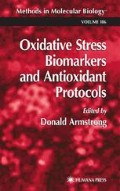Abstract
The detection of free radicals is often carried out by electron spin resonance (ESR) techniques. The procedure is specific and very sensitive (provided the radicals have a sufficiently long half-life to be measured). In the case of extremely short-lived free radicals, which are difficult to directly detect by ESR, spin-trapping procedures have been developed based on reaction of highly reactive radicals with a “spin trap,” generating an adduct free radical having a longer half-life and suitable for detection by regular ESR procedures (1–4). A variety of spin traps have been described in the literature, each optimal for given experimental conditions or specific free radicals to be detected (1–4). Hydroxyl (OH) radical detection by spin trapping and ESR procedures often has been done using 5,5-dimethylpyrroline N-oxide (DMPO) as the spin trap (5–9). This spin trap very rapidly reacts with OH to produce a stable free radical adduct having a characteristic ESR spectrum (5–9).
Access this chapter
Tax calculation will be finalised at checkout
Purchases are for personal use only
References
Halliwell, B. and Gutteridge, J. M. C. (1991) Free Radicals in Biology and Medicine (2nd ed.). Clarendon Press, Oxford, UK, pp. 47–58.
Aust, S. D., Chignell, C. F., Bray, T. M., Kalyanaraman, B., and Mason, R. P. (1993) Free radicals in toxicology. Toxicol. Appl. Pharmacol. 120, 168–173.
Janzen, E. G. (1984) Spin trapping. Methods Enzymol. 105, 188–198.
Knecht, K. T. and Mason, R. P. (1993) In vivo spin trapping of xenobiotic free radical metabolites. Arch. Biochem. Biophys. 303, 185–194.
Buettner, G. R. (1993) The spin trapping of superoxide and hydroxyl free radicals with DMPO (5,5-dimethylpyrroline-N-oxide): more about iron. Free Rad. Res. Commun. 19, S79–S83.
Burkitt, M. J. (1993) ESR spin trapping into the nature of the oxidizing species formed in the Fenton reaction: pitfalls associated with the use of 5,5-dimethyl-1-pyrroline-N-oxide in the detection of the hydroxyl radical. Free Rad. Res. Commun. 18, 43–57.
Rashba-Step, J., Turro, N. J., and Cederbaum, A. L. (1993) Increased NADPH and NADH-dependent production of superoxide and hydroxyl radical by microsomes after chronic ethanol treatment. Arch. Biochem. Biophys. 300, 401–408.
Rashba-Step, J., Turro, N. J., and Cederbaum, A. L. (1993) ESR studies in the production of reactive oxygen intermediates by rat liver microsomes in the presence of NADPH or NADH. Arch. Biochem. Biophys. 300, 391–400.
Reinke, L. A., Rau, J. M., and McCay, P. B. (1994) Characteristics of an oxidant formed during iron (II) autoxidation. Free Rad. Biol. Med. 16, 485–492.
Castro, G. D., Lopez, A. J., and Castro, J. A. (1988) Evidence for hydroxyl free radical formation during Paraquat but not for Nifurtimox liver microsomal biotransformation. A dimethyl sulfoxide scavenging study. Arch. Toxicol. 62, 355–358.
Janzen, E. G., Krygsman, P. H., and Haire, D. L. (1988) The application of gas chromatographic/mass spectrometric techniques to spin trapping. Conversion of α-phenyl N-tert-butylnitrone (PBN) spin adducts to stable trimethylsilylated derivatives. Biomed. Environ. Mass Spectrom. 15, 111–116.
Janzen, E. G., Towner, R. A., Krygsman, P. H., Haire, D. L., and Poyer, J. L. (1990) Structure identification of free radicals by ESR and GC/MS of PBN spin adducts from the in vitro and in vivo rat liver metabolism of halothane. Free Rad. Res. Commun. 9, 343–351.
Janzen, E. G., Towner, R. A., Krygsman, P. H., Lai, E. N., Poyer, J. L., Bruegge-mann, G., and McCay, P. B. (1990) Mass spectroscopy and chromatography of the trichloromethyl radical adduct of phenyl tert-butyl nitrone. Free Rad. Res. Commun. 9, 353–360.
Hong Sang, Janzen, E. G., Poyer, J. L., and McCay, P. B. (1997) The structure of free radical metabolites detected by EPR spin trapping and mass spectroscopy from halocarbons in rat liver microsomes. Free Rad. Biol. Med. 22, 843–852.
Albano, E., Tomasi, A., Goria-Gatti, L., and Dianzani, M. U. (1988) Spin trapping of free radical species produced during the microsomal metabolism of ethanol. Chem. Biol. Interact. 65, 223–234.
Castro, G. D., Delgado de Layño, A. M. A., and Castro, J. A. (1997) Hydroxyl and 1-hydroxyethyl free radicals detection using spin traps followed by derivatization and gas chromatography-mass spectrometry. Redox Report 3, 343–347.
Finkelstein, E., Rosen, G. M, and Rauckman, E. J. (1980) Spin trapping of superoxide and hydroxyl radical: Practical aspects. Arch. Biochem. Biophys. 200, 1–16.
Castro, G. D., Delgado de Layño, A. M. A., and Castro, J. A. (1998) Liver nuclear ethanol metabolizing system (NEMS) producing acetaldehyde and 1-hydroxyethyl free radicals. Toxicology 129, 137–144.
Abe, K., Suezawa, H., Hirota, M., and Ishii, T. (1984) Mass spectrometric determination of spin adducts of hydroxyl aryl free radicals. J. Chem. Soc. Perkin Trans. II. 29–34.
Janzen, E. G., Kotake, Y., and Hinton, R. D. (1992) Stabilities of hydroxyl radical spin adducts of PBN-type spin traps. Free Rad. Biol. Med. 12169–173.
Kotake, Y. and Janzen, E. G. (1991) Decay and fate of the hydroxyl radical adduct of α-phenyl-N-tert-butylnitrone in aqueous media. J. Am. Chem. Soc. 113, 9503–9506.
Chen, G., Bray, T. M., Janzen, E. G., and McCay, P. B. (1991) The role of mixed function oxidase (MFO) in the metabolism of the spin trapping agent α-phenyl-N-tert-butyl-nitrone (PBN) in rats. Free Rad. Res. Comms. 14, 9–16.
Author information
Authors and Affiliations
Editor information
Editors and Affiliations
Rights and permissions
Copyright information
© 2002 Humana Press Inc.
About this protocol
Cite this protocol
Castro, J.A., Castro, G.D. (2002). Hydroxyl and 1-Hydroxyethyl Radical Detection by Spin Trapping and GC-MS. In: Armstrong, D. (eds) Oxidative Stress Biomarkers and Antioxidant Protocols. Methods in Molecular Biology™, vol 186. Humana Press. https://doi.org/10.1385/1-59259-173-6:89
Download citation
DOI: https://doi.org/10.1385/1-59259-173-6:89
Publisher Name: Humana Press
Print ISBN: 978-0-89603-850-9
Online ISBN: 978-1-59259-173-2
eBook Packages: Springer Protocols

